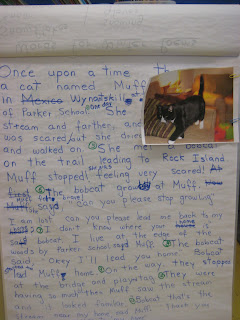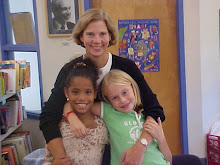 |
| 4th grade math students explore together how to draw 2D representations of 3D objects. Students can then make drawings from their own designs for others to try recreating. |
 |
| K-1's all contributed to this story about an unlikely friendship between a bobcat and a cat at Parker. They are going to turn their story into a book. |
1. Learners
have to be at the center of what happens in the classroom.
2. Learning is a social practice and can’t happen alone.
3.
Emotions are an integral part of learning.
4.
Learners are different.
5.
Students need to be stretched, but not too much.
6.
Assessment should be for learning, not of learning.
7.
Learning needs to be connected across disciplines.I would take it one step further than she does, adding "8. Learning should result in purposeful action." This concept includes projects that have a purpose beyond the school's walls - learning that expands into the world beyond the classroom. That is what gives the depth and meaning to activities that will excite students' imaginations and passions.







